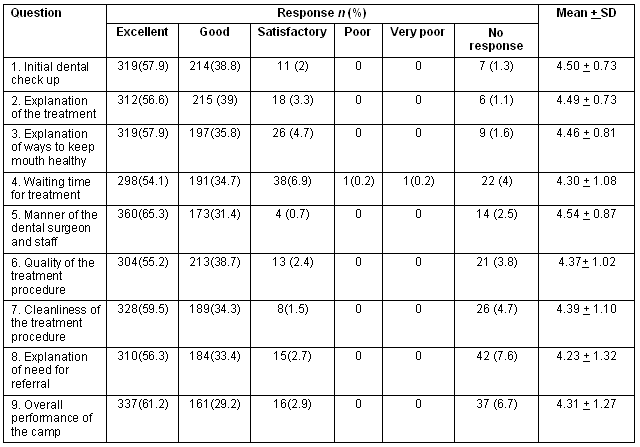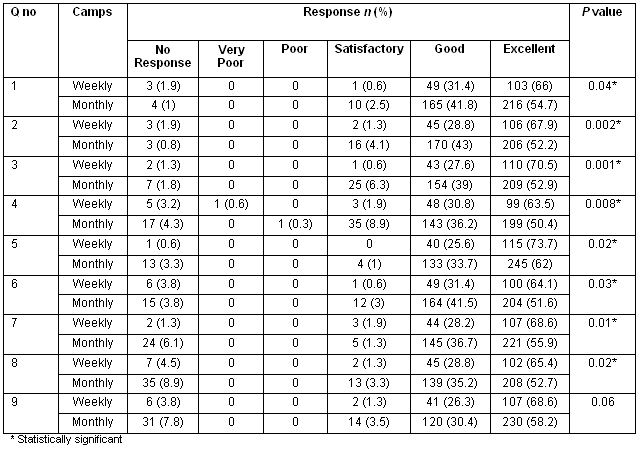Concern about the doctor-patient relationship was documented as far back as Hippocrates. In more recent times, patient satisfaction and the nature of the doctor-patient relationship have been investigated as potential keys to better understanding the health care process.1
With the shift in health care from a seller's to a buyer's market and the advent of the concept of 'consumerism' in the sense of patients being 'consumers' of care, research into patient satisfaction has gained greater prominence. In addition, patient satisfaction is becoming an increasingly important indicator of the quality of dental care. Patient satisfaction with dental care has an added importance regarding an association between satisfaction with care and patient behavior, in terms of compliance and utilization of services. Patient satisfaction is a multidimensional concept. Some identified dimensions of dental care satisfaction include: the technical or aspects of care related to the process of diagnosis and treatment; interpersonal aspects; accessibility/availability; financial access; efficacy/outcomes; continuity of care; facilities; and general attitudes about overall care1,2.
In developing countries such as India, ensuring adequate access to oral health care services and improving the level of oral health are health policy major concerns. Seventy-five percent of the Indian population resides in 580 781 villages of different sizes and population density. Although the overall dentist : population ratio has improved from 1:80 000 to 1:27 000 during the last decade, rural areas still have only one dentist caring for 300 000 people3.
Reducing disparities requires far-reaching approaches that target populations at highest risk of specific oral disease, and involves improving access to existing care4. As has been seen in several developing countries, the greatest challenge is to offer essential oral health care in the context of primary health programs. The health policy of India envisages providing 'health for all' through a primary health care approach3. Such programs should meet the basic health needs of the population, strengthen active outreach to the community, organize primary care, and ensure effective patient referral. In order for such programs to be successful, integration and participation of the government, health institutions and, primarily, the community is mandatory.
One such initiative is to provide primary oral health care to a rural population. Manipal College of Dental Sciences, Mangalore, a unit of Manipal University, conducts regular outreach dental camps on a weekly and monthly basis. However, the success of any oral health program depends largely on how it meets the needs and expectations of the target community. Therefore, the present study was designed to evaluate patient satisfaction at various rural outreach dental camps conducted by the institution over the period of one year.
Overview
Outreach dental camps are routinely conducted by Manipal College of Dental Sciences, Mangalore in order to take the dental services to rural communities. The institute conducts three weekly camps and two additional camps during weekdays. There is also a regular monthly camp and others as and when organized
The activities include patient education, thorough dental examination and consultation, temporary restorations, extractions and referrals.
Patients attending the outreach camps are first registered and then undergo an initial examination. Any diagnosis and required treatment is explained to the patient, followed by oral hygiene instructions. Depending on the chief complaint, a treatment plan is made and explained to the patient. Patients are referred to the dental clinics of the institute if the treatment cannot be provided in the camp.
Methods
Ethical clearance was obtained from the institutional review board.
From January to December 2006 a total of 1596 patients gained treatment at the outreach dental camps. The questionnaire was given to patients after receiving treatment and before leaving the camp venue (a convenient sampling method). Of the 900 questionnaires distributed, 551 were completed and returned (61.2% response rate).
The patient satisfaction questionnaire was developed in the local Kannada language and was designed for easy use by patients, who had only to mark the appropriate boxes for their answers. Questions 1 to 9 required the use of a Likert scale to grade the services received: from 1 = very poor, to 5 = excellent. The reliability of the questionnaire was good (Cronbach's alpha = 0.75).
The completed questionnaires were collected and analyzed using SPSS v 10 (SPSS Inc; Chicago, IL, USA). A frequency distribution of responses was performed. A χ2 test was used to compare the responses from weekly camps with those of monthly camps. The test was also used to compare mean satisfaction scores from weekly camps with monthly camps, and among individual months.
Results
A total of 156 answered questionnaires from weekly camps and 395 from monthly camps were collected from January 2006 to December 2006. The highest mean satisfaction score (4.54 ± 1.08) was observed for the question on the manner of the dental surgeon, dental assistant and other dental staff. A total of 65.3% of the patients regarded this aspect as excellent, followed by 31.4% who regarded it as good. With regard to overall performance of the camp, 61.2% rated this excellent with a mean score of 4.31 ± 1.27. All other aspects of the dental camp were rated excellent by more than half the patients. The mean scores for all aspects were above score 4 (Table 1).
Comparison of patient satisfaction at weekly camps with monthly camps revealed that 67.5% of the patients regarded all aspects of the weekly camps as excellent; whereas, 54.5% regarded monthly camps similarly. The manner of the dental surgeon, dental assistant and the dental staff were regarded as excellent by 73.3% of the weekly camp patients and 62% of the monthly camp patients. The comparison of responses to all aspects of the weekly as well as monthly camps was statistically significant, except for the overall performance of the camp (p = 0.06) (Table 2).
The mean satisfaction scores for the weekly camp (4.51 ± 1.02) was significantly higher than for the monthly camps (4.23 ± 1.35) (p = 0.017) (Table 3)
The mean patient-satisfaction score for the year 2006, from January to December, was 4.31 ± 1.27 (Table 4). The highest mean satisfaction score was for the month of May (4.70 ± 0.88), followed by September (4.64 ± 0.87) and July (4.61 ± 0.92). The least mean satisfaction score was for the camps held in month of November (3.16 ± 2.15). The comparisons of the mean satisfaction scores for the individual months were also statistically significant (p = 0.001).
Table 1 : Frequency distribution of responses to the questions

Table 2 : Comparison of responses between weekly and monthly camps

Table 3 : Mean satisfaction scores for weekly and monthly camps

Discussion
Virtually every organization is now concerned with satisfying the users of its products or services, be they known as clients, customers, consumers or patients. Against a background of growing consumerism, satisfying patients has become a key task for all healthcare providers5. The present study was conducted to assess the patient satisfaction at various rural outreach dental camps, as described.
The results showed that overall mean patient satisfaction with the care received ranged from satisfactory (3.16) to excellent (4.70) (Mean Score 4.31 ± 1.27). The mean score for each question was always above 4, indicating good to excellent patient satisfaction. The manner of the dental surgeon, dental assistant and other dental staff was in the highest rated category, followed by the initial dental examination.
Weekly camps saw fewer patients, enabling the provision of treatment in a less hurried fashion than at monthly camps. Moreover, at weekly camps more treatment modalities could also be provided per patient, and recall and review could be performed more frequently than at monthly camps. These factors could account for higher patient satisfaction with the weekly camps.
Dental health care satisfaction is an integral part of the dental healthcare professional's obligation to society. Even if the clinical outcome is optimal, if patients are not satisfied, the dental team has not reached its goal5. In the present study, the manner of the dental surgeon, dental assistant and other dental staff was regarded as excellent by most patients (65.3%), which could be one of the reasons for a high satisfaction level among the patients treated. This is similar to the findings of Zini et al6, who reported that the two highest predictors of patient satisfaction were the professionalism of the dentist (41.4%) and a good attitude of dentists towards the patients.
The success of dental camps depends largely on how it meets the needs and expectations of the target population. The use of dental care is motivated not only by objective clinical needs, as defined by the dentists, but also by subjective feelings of illness. One of the roles of dental camps is to satisfy the needs of the community in the following ways. Basic treatments are provided in a context of comprehensive oral health care, free of cost with the main motive being to cater for the dental needs of those at economic disadvantage. The cost factor does play a role in patient satisfaction. Even when a minimal charge is made for care, patients' expectations regarding that cost must be addressed with clear explanations provided regarding the expected cost of care.
As explained in a review of the dental patient satisfaction literature, the five practice attributes that affect patient satisfaction are: technical competence, interpersonal factors, convenience, cost, and facilities7. The exemplary patient satisfaction scores seen in this study does indeed reconfirm these attributes were present.
However, the results of this study must be interpreted with some caution and limitation. First, the survey instrument was based on commonly identified aspects of patient satisfaction and, because the study involved rural population, a Kannada (local language) version was used. Therefore, comparison with other studies using standard instruments like the Dental Satisfaction Questionnaire (DSQ)8,9 or Dental Visit Satisfaction Scale (DVSS)10 is not possible. Accordingly, the instrument may not be appropriate for use in other population. Nevertheless, the internal consistency of the instrument had a value of 0.75, indicating good reliability. Second, demographic factors such as age, gender and number of patients for each month were not taken into consideration because they did not influence patient satisfaction. Finally, the completion of the questionnaire was not accounted for. So, questions that had a non-response could have made significant difference in the analysis.
Conclusion
In conclusion, The overall high level of patient satisfaction reflected the dental team's approach of responsibility and accountability of towards the target population. In outreach dental treatment programs, comprehensive oral health care with adequate review of patients should ensure satisfaction in patients.
Acknowledgement
The authors thank Dr V Surendra Shetty, Dean, Manipal College Of Dental Sciences, Mangaloreand the other concerned authorities of the institution for their support and co-operation.
References
1. Kress GC, Jr. Patient Satisfaction with dental care. Dental Clinics of North America 1988; 32(4): 791-802.
2. Mascarenhas AK. Patient satisfaction with comprehensive care model of dental care delivery. Journal of Dental Education 2001; 65(11): 1266-1271.
3. Shah N. Geriatric oral health issues in India. International Dental Journal 2001; 51: 212-218.
4. The World Oral Health Report. Continuous improvement of oral health in the 21st century - the approach of the WHO global oral health programme. Geneva: WHO, 2003.
5. Newsome PRH, Wright GH. A review of patient satisfaction;1. Concepts of satisfaction. British Dental Journal 1999; 186: 161-165.
6. Zini A, Pietrokovsky J, Dgani A, Dgani R, Handelsman M. Survey of patient satisfaction at the Yad Sarah Geriatric Dental Clinic. Refuat Hapeh Vehashinayimv 2006; 23(1): 36-41.
7. Butters JM, Willis DO. A comparison of patient satisfaction among current and former dental school patients. Journal of Dental Education 2000; 64: 409-415.
8. Davies AR, Ware JE. Measuring patient satisfaction with dental care. Social Sciences and Medicine 1981; 15A: 751-760.
9. Davies AR, Ware JE, Jr. Development of dental satisfaction questionnaire for the health insurance experiment. Santa Monica, CA: The Rand Corporation, 1982.
10. Corah NL, O'Shea RM, Pace LF, Seyrek SK. Development of a patient measure of satisfaction with the dentist: The Dental Visit Satisfaction Scale. Journal of Behavioral Medicine 1984; 7: 367-373.
